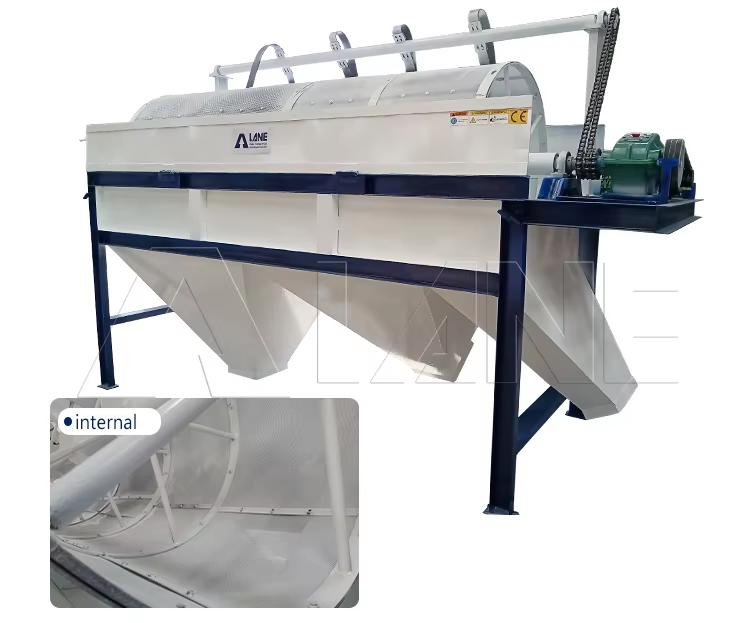
The rotary screener is a commonly used equipment in the production of compound fertilizers, mainly used for the separation of finished products and returned materials, and can also achieve the classification of finished products, making them evenly classified. The drum device is installed obliquely on the frame. The electric motor is connected to the drum device through a reducer and a coupling, driving the drum device to rotate around its axis. The rotary screener has been widely used in the field of material screening due to its high efficiency screening, simple operation, and easy maintenance.
A rotary screener is a device that uses a rotating drum to screen materials, widely used in industries such as mineral processing, chemical engineering, and food. Its working principle is based on the difference in particle size to achieve material classification. During the working process, the equipment starts first and the drum begins to rotate. Then, the materials that need to be screened are fed into the drum. The drum is usually inclined or placed horizontally, with screens of different sizes inside. When the drum rotates, the material is lifted to a certain height with the rotation of the cylinder, and then falls under the action of gravity.
In this process, smaller particles of material fall into the collection hopper through the sieve holes, while larger particles are blocked inside the sieve, thus achieving material classification. The screening efficiency and accuracy of the rotary screener are affected by the drum speed, screen size, and material characteristics. This screening method not only improves screening efficiency, but also allows materials to be more evenly dispersed on the screen due to the continuous rotation of the drum, reducing clogging of the screen holes. In addition, the structural design of the rotary screener usually considers ease of maintenance and operation, making the replacement of the screen mesh and cleaning work simple and fast.
The design of a rotary screener usually includes one or more cylindrical screens, which have different sizes and shapes depending on the required screening accuracy. The material and structure of the sieve are key factors that need to be selected based on the abrasiveness of the screened material. When handling highly abrasive materials, more durable mesh materials such as steel or polyurethane may be required. The rotational speed of the drum is also an important operating parameter, which affects the residence time of materials on the sieve and the screening effect. Usually, the higher the rotational speed, the better the dispersion of the material, but excessively high rotational speed may cause the material to become too fragmented.
In order to adapt to different industrial applications, rotary screener may be equipped with multiple configuration options, including different feeding methods, discharge port designs, and drive systems. The feeding system needs to ensure that the material enters the drum evenly, while the discharging system needs to effectively separate and transport the screened material. Some efficient drum screening machines may also be equipped with automatic cleaning systems to regularly remove blockages on the screen and maintain screening efficiency.
In practical applications, drum screening machines are usually used together with other equipment such as feeders, conveyors, and elevators to form a complete material processing production line. This integrated design can improve the production efficiency of the entire system, reduce manual intervention, and optimize material flow.
Overall, the rotary screener is an efficient and reliable screening equipment with a simple structure, easy operation, low maintenance costs, and the ability to provide continuous and stable screening results. By selecting and configuring the drum screening machine reasonably, the efficiency and accuracy of material processing can be greatly improved, meeting the needs of production.
For more information, please contact us by sending an inquiry today! We can help you!

World-class and Energy-saving Operation, Factory Price & Fast Delivery.